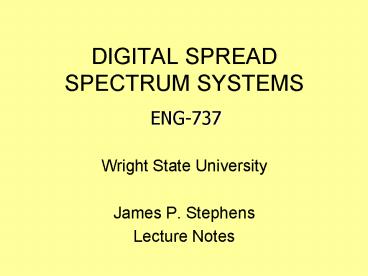DIGITAL SPREAD SPECTRUM SYSTEMS - PowerPoint PPT Presentation
1 / 15
Title:
DIGITAL SPREAD SPECTRUM SYSTEMS
Description:
Rs = Symbol (baud) rate = 1/T symbols / sec. Rb = Information rate = 1/T bits / sec ... Rs = symbol (baud) rate = 1/T symbols/sec. Rb = information rate = 1/T Log2M ... – PowerPoint PPT presentation
Number of Views:274
Avg rating:3.0/5.0
Title: DIGITAL SPREAD SPECTRUM SYSTEMS
1
DIGITAL SPREAD SPECTRUM SYSTEMS
ENG-737
- Wright State University
- James P. Stephens
- Lecture Notes
2
WHAT WILL YOU LEARN ?
- Learn the definition of SS
- Understand the reason for using SS
- Learn to distinguish between various modulation
types - Learn the concept of signal dimensionality and
how it relates to processing gain - Understand the significance of PN sequences,
their properties, how to generate them, and how
to exploit them - Understand at the block diagram level, the
function of each subsystem, i.e. modulation,
demodulation, acquisition, tracking, etc - Learn how to determine system performance
- Understand a variety of commercial SS
applications - Gain exposure to new areas of digital
communications
3
SPREAD SPECTRUM SYSTEMS
- Overview
- Digital Communications Review
- Spectrum Spreading Concepts
- Pseudorandom Codes
- Direct Sequence Systems
- Frequency Hopping Systems
- Synchronization of SS Systems
- Applications of Spread Spectrum
4
Generic Digital Communication System
5
OVERVIEW
- DEFINITION
- Spread spectrum (SS) is a means of signal
transmission in which
- The transmitted signal occupies a bandwidth which
is much greater than the minimum necessary to
send the information. - Spreading is accomplished by means of a spreading
signal called a code signal, which is
independent of the data. - At the receiver, despreading is done by
correlating the received SS signal with a
synchronized replica of the spreading signal.
6
WHY SPREAD SPECTRUM ?
- Interference Suppression
- Antijam capability
- Natural interference rejection
- Self-interference (multipath protection)
- Energy Density Reduction
- Low probability of intercept (LPI)
- Low probability of exploitation (LPE)
- National allocation regulations
- High-Resolution Ranging
- Multiple Access
- Communications resource sharing
- Communications privacy
7
BASIC SPREAD SPECTRUM TECHNIQUE
Interference Signal
Spread Signal
Recovered Data
Data Signal
Spreading Code
Spreading Code
Synchronized
- The essence of interference rejection capability
in SS systems can be summarized as
- Multiplication once by the spreading code spreads
the signal bandwidth - Multiplication twice by the spreading code
followed by filtering, recovers the original data
signal - The desired signal gets multiplied twice, but the
interference gets multiplied only once
8
SPREAD SPECTRUM TECHNIQUES
- Direct Sequence (DS) - A carrier is modulated by
a digital code sequence in which bit rate is much
higher than the information signal bandwidth. - Frequency Hopping (FH) - A carrier frequency is
shifted in discrete increments in a pattern
dictated by a code sequence. - Time Hopping (TH) - Bursts of the carrier signal
are initiated at times dictated by a code
sequence. - Hybrid Systems - Use of combination of the
above. - Others - Carrier-less based, transform domain
systems
9
DIGITAL COMMUNICATION REVIEW
- Terms and definitions
- Signal and system analysis
- Digital modulation techniques
- Detection of digital signals in noise
8
10
INFORMATION RATE vs. SYMBOL RATE
- Information in its most fundamental form is
measured in bits (binary digits) - A signal which conveys binary information is the
binary digital waveform
3
5
4
2
1
t (ms)
5T
4T
3T
2T
T 1ms
Rs Symbol (baud) rate 1/T symbols / sec Rb
Information rate 1/T bits / sec Example Rs
1000 symbols / sec Rb 1000 bits /
sec
11
INFORMATION RATE vs. SYMBOL RATE (Continued)
- Binary information can be conveyed by M-ary
(multilevel) digital waveforms
Rs symbol (baud) rate 1/T symbols/sec Rb
information rate 1/T Log2M Where M number of
levels in the M-ary waveform For the example
shown Rs 333 symbols/sec Rb 1000 bits/sec
12
(No Transcript)
13
(No Transcript)
14
PERFORMANCE CRITERIADigital vs. Analog Systems
- Analog communication systems reproduce waveforms
(an infinite set) - A figure of merit for analog systems is a
fidelity criterion (e.g. percent distortion
between transmitted and recovered waveforms) - Digital communication systems transmit waveforms
that represent digits (a finite set) - A figure of merit for digital systems is the
quantity of incorrectly detected digits
15
WHY DIGITAL?
But let your communication be, Yea, yea Nay,
nay for whatever is more that these, cometh of
evil. - The Gospel According to St.
Matthew (537)
- Demand Increased requirement for computer to
computer communications - Signal Regeneration Resistant to noise,
interference, and distortion - Digital Signal Processing Allows error detection
and correction permits ease of encryption and
use of AJ techniques - Technology Digital communication systems are
more flexible and are better suited for future
communication needs - Economics Components are becoming increasingly
more available and less expensive. Ability to
rapidly troubleshoot and repair systems reduce
overall maintenance costs as well as increasing
system availability































